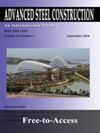钢结构的高阶非线性分析。第二部分:精细塑性铰公式
IF 1.7
3区 工程技术
Q3 CONSTRUCTION & BUILDING TECHNOLOGY
引用次数: 23
摘要
在本论文中,提出了一种改进的拉格朗日公式中的四阶元素公式来处理几何非线性。本论文的公式通过提出一种改进的塑性铰方法来分析具有许多成员的大型钢架结构,将其扩展到包括材料非线性,对于基于塑性区方法的当代算法在计算上可能存在问题。这个概念是传统塑性铰方法的进步,因为改进的塑性铰技术允许逐渐屈服,被认为是单元截面上的分布塑性,完全塑性的条件,以及包括应变硬化。该方法建立在以力合力解析指定的相互作用屈服面上,对几何非线性和材料非线性较大的大型框架实现了精确、快速的收敛。这些解决方案在准确性和计算便捷性的平衡方面被证明是有效的。除了数值效率之外,目前的通用方法能够捕获钢结构一般应用中不同种类的材料和几何非线性,从而为工程实践提供了评估结构非线性行为的有效和准确的手段。本文章由计算机程序翻译,如有差异,请以英文原文为准。
HIGHER-ORDER NON-LINEAR ANALYSIS OF STEEL STRUCTURES PART II : REFINED PLASTIC HINGE FORMULATION
In the companion paper, a fourth-order element formulation in an updated Lagrangian formulation was presented to handle geometric non-linearities. The formulation of the present paper extends this to include material non-linearity by proposing a refined plastic hinge approach to analyse large steel framed structures with many members, for which contemporary algorithms based on the plastic zone approach can be problematic computationally. This concept is an advancement of conventional plastic hinge approaches, as the refined plastic hinge technique allows for gradual yielding, being recognized as distributed plasticity across the element section, a condition of full plasticity, as well as including strain hardening. It is founded on interaction yield surfaces specified analytically in terms of force resultants, and achieves accurate and rapid convergence for large frames for which geometric and material non-linearity are significant. The solutions are shown to be efficacious in terms of a balance of accuracy and computational expediency. In addition to the numerical efficiency, the present versatile approach is able to capture different kinds of material and geometric non-linearities on general applications of steel structures, and thereby it offers an efficacious and accurate means of assessing non-linear behaviour of the structures for engineering practice.
求助全文
通过发布文献求助,成功后即可免费获取论文全文。
去求助
来源期刊

Advanced Steel Construction
CONSTRUCTION & BUILDING TECHNOLOGY-ENGINEERING, CIVIL
CiteScore
2.60
自引率
29.40%
发文量
0
审稿时长
6 months
期刊介绍:
The International Journal of Advanced Steel Construction provides a platform for the publication and rapid dissemination of original and up-to-date research and technological developments in steel construction, design and analysis. Scope of research papers published in this journal includes but is not limited to theoretical and experimental research on elements, assemblages, systems, material, design philosophy and codification, standards, fabrication, projects of innovative nature and computer techniques. The journal is specifically tailored to channel the exchange of technological know-how between researchers and practitioners. Contributions from all aspects related to the recent developments of advanced steel construction are welcome.
 求助内容:
求助内容: 应助结果提醒方式:
应助结果提醒方式:


